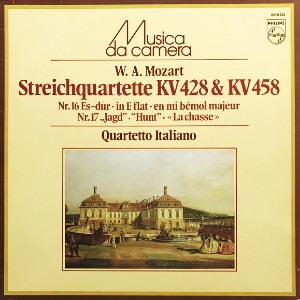 |
|
Philips
- 1 LP - 6570 922
|
|
QUARTETTO ITALIANO
- Paolo Borciani, Elisa Pegreffi, violino
- Piero Farulli,
viola
- Franco Rossi, violoncello |
|
|
|
|
|
Luogo e data
di registrazione |
|
ThÚÔtre
Vevey, Vevey (Svizzera)
- 14 agosto / 1
settembre 1966 |
|
|
Registrazione: live
/ studio |
|
studio |
|
|
Producer / Engineer |
|
Vittorio Negri |
|
|
Edizione LP |
|
Philips | 6570
922
| 1
LP |
|
|
Prima Edizione CD |
|
Vedi link alla prima
edizione in long playing.
|
|
|
Note |
|
La
collana
"Musica da
Camera" della
Philips
riedita negli
anni
'80
alcune
registrazioni
del Quartetto
Italiano. |
|
|
|
|
The
six string
quartets
written
between
December 1782
and January
1785, which
Mozart sent to
Joseph Haydn
with a
splendid
letter of
dedication,
represent the
peak of his
chamber music.
The master,
who usually
composed
without undue
difficulty,
acknowledged
that they were
"the fruit of
long and
painstaking
work." The
individualisation
of the parts,
which has
matured here
to the peak of
perfection and
made the
writing of
quartets the
hallmark of
composition at
its highest
level for the
whole
nineteenth
century, did
not come
easily even so
Mozart.
Haydn's
"Russian"
Quartets from
the year 1781
may have been
the model and
provided the
stimulus, but
Mozart goes
his own way
and does not
copy his older
friend. The
thematic work,
exploiting the
finest
relationships
between
motifs, in the
means which
serves the
individualisation
of the voices,
but Mozart
manipulates it
in a highly
personal way.
In these
quartets he
strikes a
balance
between
personal
expression and
formal
discipline
which was not
surpassed even
by Beethoven.
The
String Quartet
in E flat, K.
428 was
written presumably
in June and
July of 1783,
and takes
third place
chronologically
in the series
of six. Unlike
Haydn, who
preferred to
work
monothematically,
Mozart
contrasts two
themes in the
first movement
- a first
subject played
in unison and
a second
subject
beginning with
a turn, the
start of which
plays an
important role
in the canonic
development
section. Just
how far Mozart
is removed in
expression
from his model
Haydn may be
seen in the Andante
con moto,
an almost
Romantic
movement in
6/8 time,
dominated by a
varying
three-note
motif played
first on the
cello and
pervaded by a
type of
chromaticism
which almost
seems to
anticipate
Wagner's
"Tristan." In
its emotional
intensity and
expressiverness
the movement
points far
into the
future. On the
other hand,
the minuet,
beginning with
a characteristic
octave leap,
is more
reminiscent of
Haydn. The
contrast of
the trio in C
minor has a
strange effect
- a melancholy
interspection
which
nevertheless
faits to
dampen the
gaiety of the
dance
movement. The
joy
of
music-making,
typical of
Haydn, comes
through also
in the
sparkling
finale, which
disperses with
any
complicated
development.
According
to Mozart's
own thematic
inventory, the
String Quartet
in B flat, K.
458 was
completed on
November 9,
1784. Its
title "Hunt,"
which did not
come from the
main theme.
Following
Haydn's
pattern,
theexposition
is based on
one theme but,
as though to
compensate for
this, the
beginning of
the
development
comes up with
a surprisingly
indulgent
lyrical idea.
The coda,
beginning with
a pedal point
on the cello,
is greatly
extended and
is so full of
material that
it acts as a
second
development
section. The
minuet - more
a cantabile
movement
with a
capricious
trio - taken
second place
on this
occasion. The
high point of
the work is
the Adagio,
which like the
slow movement
of K. 428,
seems to
introduce
elements of
Romanticism.
It is a piece
with flowing
melodies,
deeply charged
with feeling
and
alternating
between major
and minor.
Here, too,
chromaticism
plays a key
role, this
time in the
form of
a
chromatic
suspension
determining
the second
subject. The
rondo finale
uses as its
main idea the
melody of a
folk-song
which has
already
appeared in
the
Divertimento
K. 252. A
middle
section, like
a development,
treats the
beginning of
the theme in a
virtuoso
maneer, in the
style of
Haydn. But the
cheerful charm
of the
movement is
set out
differently
from Haydn's
direct,
exultant
humour. Even
in such
pieces, where
the model can
be seen,
Mozart remains
for ever
unique.
Alfred
Beaujean
|
| Illustration:
Bernardo Bellotto (1720-1780)
"Schlo▀hof bei Marchegg.
Hofwiese" (Kunsthistorisches
Museum, Wien) |
|